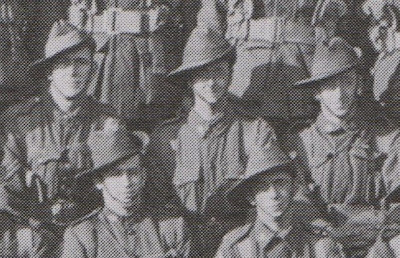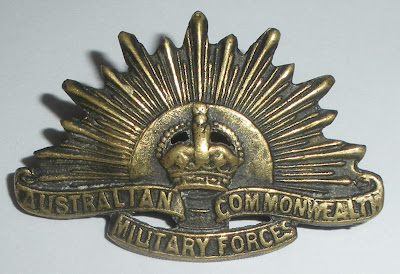AIF Online Museum
An online collection of artifacts from the Australian Imperial Force, 1914-1919
About Me

- AIF Online Museum
- Welcome to the AIF Online Museum, a virtual exhibition of artifacts pertaining to the Australian Imperial Force that are held in my private collection.
Search the Museum
Useful AIF related links.
- The AIF Online Museum on Twitter
- Battlefield Colloquialisms of the Great War
- Australians on the Western Front 1914–1918
- The AIF Database
- Australian War Memorial
- ANZACS Online
- First World War Official Histories at the AWM Website
- AIF Order of Battle 1914-1918
- AIF Casualties on the Western Front 1916-1918. Listed month by month
- Gallipoli and the ANZACS
- Australian National Archives Service Records Information
- Commonwealth War Graves Commision
- Australian War Graves Photographic Archive
- Great War Forum
- The Western Front Association
- The Australian Light Horse Studies Centre
- In From The Cold Project
- ANZAC Centenary
- The Long, Long Trail: The British Army in the Great War
Thursday, 12 July 2012
Wednesday, 27 June 2012
Volunteered For Active Service Badge, Medically Unfit: Edward Stanley Dusting
Sunday, 20 May 2012
Stretcher Bearer's Brassard
 |
 |
| A Stretcher Bearer's with brassard seen in 1918. |
Friday, 11 May 2012
Sergeant Morrish Paul Tonkin MM, 7 Light Horse Regiment, AIF
 |
| Sergeant Morrish Paul Tonkin MM 7 Light Horse Regiment wearing his Military Medal circa 1920. |
 |
| Morrish Paul Tonkin on his mount circa 1917-1918. Both photographs courtesy of Morrish's son Mr. Graham H. Tonkin. |
Tuesday, 10 April 2012
Pattern 1903 - 90 Round Bandolier: B Squadron, 12 Light Horse Regiment, AIF
Thursday, 5 April 2012
Other Ranks' Service Dress Jacket
Friday, 30 March 2012
Sam Browne Belt: Lieutenant Frank Fourro, 35 Battalion AIF
 |
| Photo of Lieutenant Frank Fourro circa 1918 wearing the exact same Sam Browne belt seen above. Courtesy of the Australian National Archives. |
Wednesday, 14 March 2012
Soldier’s Pay Book: Gunner Arthur Jones, Z5A Medium Trench Mortar Battery, AIF
Soldier’s Pay Book: Gunner Arthur Jones, Z5A Medium Trench Mortar Battery, AIF
Thursday, 8 March 2012
Identity Discs: Lance Corporal Leslie Thomas McIntyre, 59 and 60 Battalions, AIF
 |
| PERS011.1 Obverse |
 |
| PERS011.1 Reverse |
 |
| PERS011.2 Obverse |
 |
| PERS011.2 Reverse |
 | ||||||||||||||||
| PERS011.3
Center: L/Cpl L. T. McIntyre. From a group photo of 59 Battalion NCOs taken 23 November 1918. On his left is 3171 Sgt P. Little DCM MM. Picture from Give Me Back My Dear Old Cobbers, by Robin S. Corfield, Corfield and Company, Victoria 2008.
ID Number PERS011.1, .2 and .3
Title Identity Discs: Lance Corporal
Leslie Thomas McIntyre, 59 and 60 Battalions, AIF
Maker Unknown
Object Type Personal Equipment
Place made Unknown
Date made c 1916
Physical Aluminium
Description
Description
Three round aluminium identity
discs, each with a hole punched out at the top for a neck thong. The reverse
of discs .1 and .2 have the Australian coat of arms embossed on them. The obverse of disc .1 is engraved ‘1693 L.T McIntyre 59th Batt A.I.F. M’.
Disc .2 is similarly engraved,
however, the number 59 has been voided and ‘60’ has been stamped over and next
to it. The obverse of disc .1 is
engraved ‘From Les to Grace 1916’. Disc .3
is stamped ‘1693 L T MC INTYRE 60 AIF METH’.
Summary
Leslie Thomas McIntyre was a 25
year old married potter from Brunswick,
Victoria when he enlisted in the
Australian Imperial Force (AIF) on 23 February 1916. 1693 Private McIntyre
embarked for overseas on board HMAT A17 Port Lincoln on 4 May 1916 with
the 2 Reinforcement of the 59 Battalion.
He was taken on strength of the 5
Division Details at Tel el Kebir, Egypt on 9 July 1916. On 2 August
embarked at Alexandria, Egypt
and subsequently disembarked on 8 August at Marseilles,
France.
McIntyre marched into the 15 Training Battalion, Lark Hill, England
on 21 August 1916. After a period of training there, he proceeded overseas to France on 11
November. The next day he marched into 5 Australian Division Base Details,
Etaples, France. On 2 December 1916 Private
McIntyre was taken on strength of the 60 Battalion.
After spending an entire year
with his battalion he was sent to hospital sick between 1 and 12 December 1917.
After rejoining his unit McIntyre was again sent to hospital sick on 26
December. On 20 January 1918 he embarked for England
and was admitted to 1 Western Hospital, Liverpool
with pneumonia.
On 24 May 1918 Private McIntyre
began a course of instruction at the 5 Division Signal School (14 Training
Battalion). On 22 August he proceeded overseas to France
and arrived at the 5 Australian Division Base Details, Etaples, on 23 August. He rejoined the 60 Battalion on 27 August. McIntyre was appointed Lance Corporal on
16 September 1918. Nine days later, as part of the restructuring of the AIF, he
was transferred to the 59 Battalion.
Lance Corporal McIntyre returned to Australia on 10
June 1919 and disembarked at 3 Military District on 5 August 1919. He was discharged
on 19 September 1919.
The campaigns that Lance Corporal McIntyre took part in include:
Second Battle of Bullecourt: 03 May 1917 - 17 May 1917Ypres 1917: 31 July 1917 - 10 November 1917Menin Road: 20 September 1917 - 25 September 1917Polygon Wood: 26 September 1917 - 03 October 1917Poelcappelle: 09 October 1917 - 09 October 1917Passchendaele: 12 October 1917 - 12 October 1917Mont St Quentin: 31 August 1918 - 03 September 1918Hindenburg Line: 12 September 1918 - 09 October 1918
For more information on the 60th Battalion, click here.
For more information on the 59th Battalion, click here. |
Tuesday, 6 March 2012
Colour Patch Sweetheart Brooch: 11 Battalion AIF
Sunday, 4 March 2012
Rising Sun Collar Badge: Sand Cast
Subscribe to:
Posts (Atom)




















